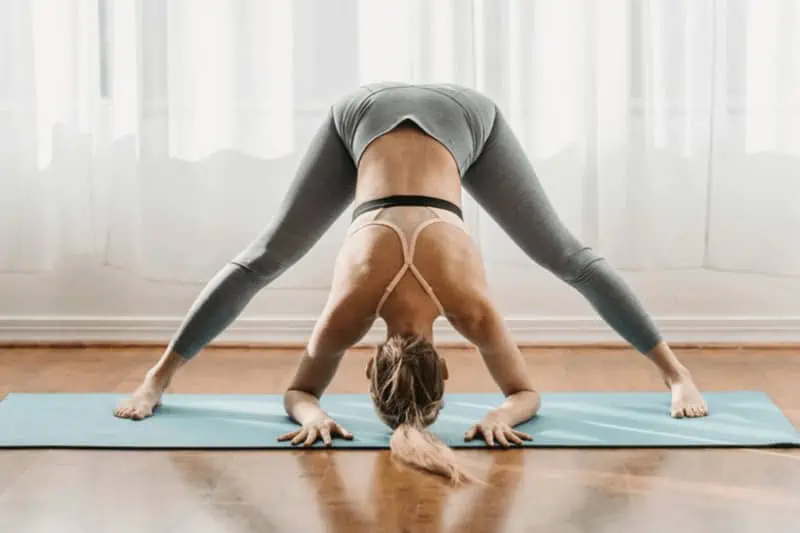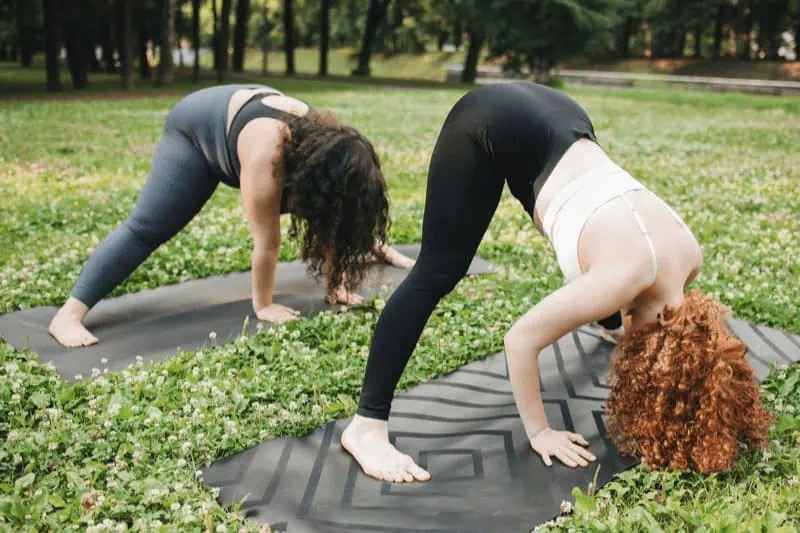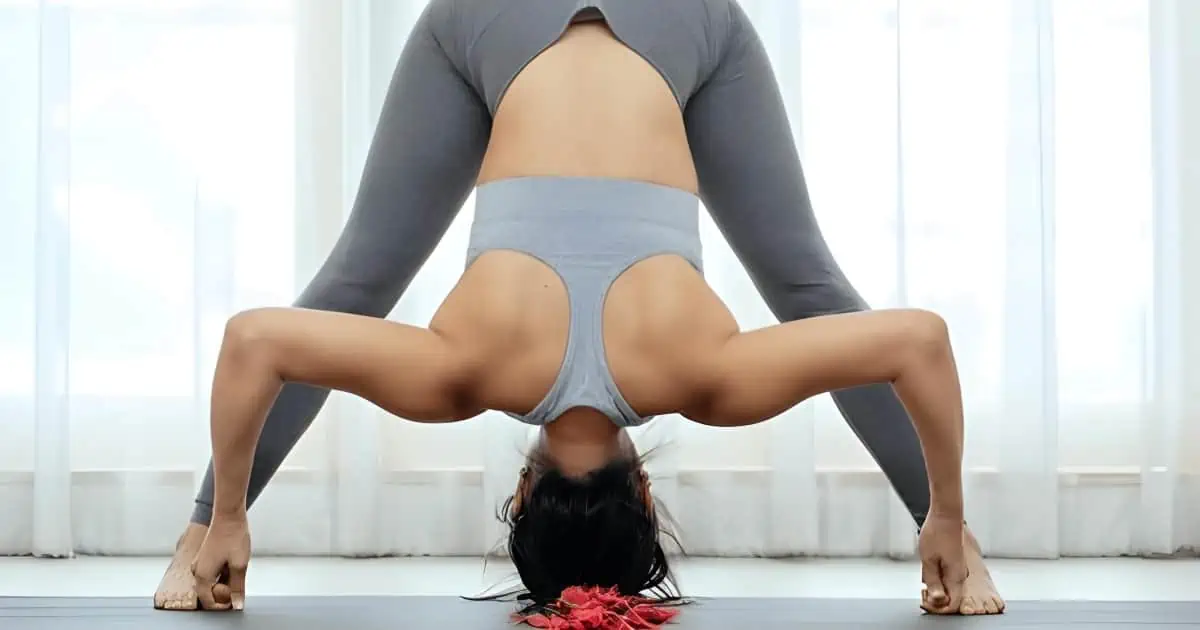Key Takeaway
Prasarita Padottanasana, or Wide-Legged Forward Bend, is a versatile yoga pose that enhances flexibility, strengthens the core, and promotes mental calmness, suitable for practitioners of all levels with appropriate modifications.
| PRASARITA PADOTTANASANA | |
|---|---|
| Alternate name: | Wide-Legged Forward Bend |
| Difficulty level: | Beginner |
| Pose category: | Standing pose, Inversion, Forward fold |
| Muscle groups: | Hamstrings (legs) Adductors (inner thighs) Calf muscles (legs) Abdominal muscles (torso) Erector spinae (back) Quadratus lumborum (back) |
| Physical benefits: | Increases flexibility in the hamstrings and calves; strengthens the back muscles. |
| Therapeutic applications: | Back pain, stress relief. |
| Preparatory poses: | Mountain Pose (Tadasana) Standing Forward Bend (Uttanasana) Chair Pose (Utkatasana) |
| Counterposes that follow well: | Goddess Pose (Utkata Konasana) Headstand (Sirsasana) |
| Chakras activated: | Root Chakra (Muladhara) |
| Most helpful prop: |  Blocks under hands - Adds support, improves alignment. See latest price |
Some of my favorite poses as a yoga teacher are the most versatile. There are many reasons people take up yoga, whether they aim to become stronger, more flexible, or less stressed. So, when I’m teaching a class, I love including poses that benefit a group of students with diverse goals.
Prasarita Padottanasana, or Wide Legged Forward Bend Pose, checks many boxes, making this posture a go-to stretch in many of my yoga sequences.
It’s versatile not only in its anatomy but in its function as well. You can add this posture to a sequence focused on standing poses, leg stretches, balancing, or inversions. Add some arm variations, and create creative flows with the Wide Legged Standing Forward Bend.
Join me as we discover the potential of Prasarita Padotanasana. We’ll offer clear steps for practicing safely and guidance for adding this asana to your own yoga sequences. Plus, you’ll learn about this asana’s name, anatomy, and how it can help your body and mind.
Roll out your mat, and let’s dive in!
Contents
- 1 Asana Overview
- 2 Step-by-Step Guide to Prasarita Padottanasana
- 3 Avoiding Common Mistakes
- 4 Modifications and Variations to Enhance Prasarita Padottanasana
- 5 The Benefits of Wide Legged Forward Bend Pose
- 6 Preparatory Poses for Prasarita Padottanasana
- 7 Integrating Prasarita Padottanasana into Your Yoga Routine
- 8 Conclusion
- 9 Frequently Asked Questions
Asana Overview
Wide Legged Forward Fold is a foundational but relatively modern yoga pose. It emerged in the library of asanas in the early 20th century when T. Krishnamacharya described Prasarita Padottanasana in the Yoga Makaranda.
Yoga Makaranda: The Nectar Of Yoga
See latest priceYoga protocol classifies this beginner-level asana with standing poses, inversions, and forward folds. Many people learn this posture as part of the Ashtanga Yoga primary series sequence, which defines four different position variations.
English and Sanskrit Names
It can be a mouthful whether you use the English or Sanskrit name for this asana! But I’ve found that if you study the Sanskrit names of different postures, the information can help you learn new poses as you begin to recognize smaller parts of long names.
Take a look at how Prasarita Padottanasana comes together:
- Prasarita: spread out, wide
- Pada: foot
- Uttana: stretched out
- Asana: posture
Can you find some cues included in the name? You may recognize “uttanasana” as the Sanskrit name for Standing Forward Bend. So, you’ll know that Prasarita Padottanasana is also a forward fold. The first part of the name gives another clear direction in this case, telling you to separate your feet.
Now that you know the meaning of the Sanskrit word pada, you don’t have to be a yoga teacher to guess that any asana containing that word in its name must have something to do with your feet. Easy, right?
It’s not always easy to pronounce the Sanskrit name correctly — even yoga teachers sometimes need guidance. When you say the Sanskrit name for Wide Legged Forward Fold, emphasize the correct syllables: “prah-SAR-ee-tah PAH-doh-TAN-NAH-sah-nah.”
Anatomy of Prasarita Padottanasana
Before we go through the steps of practicing this pose, here’s a quick overview of what muscles are involved in this posture:
- Lengthening: Hamstrings, adductors (inner thighs), calf muscles. Depending on whether you add an arm variation, you can also stretch the shoulders and chest.
- Strengthening: Abdominal muscles, erector spinae, and quadratus lumborum (back muscles)
Now that you know what the experience entails, it’s time to try it out.
Step-by-Step Guide to Prasarita Padottanasana
Wide Legged Forward Bend Pose can be a dynamic or restorative experience, but either way, it requires a solid foundation and proper alignment. Follow these steps to perfect your Prasarita Padottanasana form.
Correct Set-Up
- Begin standing in Mountain Pose. Take a big step open and turn to the side, facing the long edge of your yoga mat.
- Your feet should be separated wider than hip distance.
- Turn your toes forward so each foot is parallel to the short edges of your mat.
- Ground down through the outer edges of your feet to create a stable base.
Entering the Pose
- Place your hands on your hips. As you inhale, grow taller as you lengthen your spine.
- Exhale and hinge from your hips, keeping your spine straight.
- Bring your hands onto the floor under your shoulders as you release your upper body into your forward fold. Let your head hang with your neck relaxed.
- If you can, place your forearms on the floor. Or, extend your arms out to the sides and wrap your first two fingers around each big toe.
- Keep your breath flowing easily as you hold the stretch for 5 to 7 deep breaths.
Exiting Safely
- When you’re ready to come out of the position, bring your hands to your hips.
- Keep a microbend in your knees and begin to roll up slowly.
- Take your time and return to a standing position.
- Step your feet together, returning to your starting position at the top of your mat.
Breathing guides every movement in yoga. Use your breath intentionally to get the most out of this pose: Find length in your spine with each inhale; with each exhale, release and deepen into the stretch.

Avoiding Common Mistakes
Practicing Prasarita Padottanasana requires attention to alignment to remain balanced and injury-free. Here are some teacher-approved cues and techniques to help you nail this posture.
- Arching or rounding the spine as you fold: Be mindful of maintaining length in your spine as you bow forward, hinging at the hips. Imagine a string pulling you from the crown of your head towards the floor, keeping your spine straight and long.
- Hyperextending the knees: Locking your knees strains your joints, causing pain. To keep your joints safe and maintain stability, engage your quad muscles and keep a microbend in your knees.
- Weight distribution: Maintaining balance in this pose depends significantly on your stance. You want your legs separated a considerable distance but not so much that your feet collapse inward. Press down through the outer edges of your feet to ensure your weight is evenly distributed.
Awareness of Contraindications
Prasarita Padottanasana can be an intense stretch, especially for people with specific health issues or prior injuries. If you experience any of the following, you should approach this posture cautiously or possibly avoid it altogether.
- Lower back injury or spine issues like herniated discs
- Hamstring, hip, or groin injuries
- Dizziness or vertigo
- Glaucoma or other eye issues.
If you have any doubts about your physical condition, consult a doctor before attempting this pose.
Modifications and Variations to Enhance Prasarita Padottanasana
Prasarita Padottanasana, or the Wide Legged Forward Bend Pose, is a highly adaptable pose with numerous modifications and variations. These adjustments can enhance the stretch for shoulders, calves, and chest while accommodating different skill levels.
Props for Support
Using props like blocks or straps during Prasarita Padottanasana can provide stability and support, especially if your hamstrings are exceptionally tight.
- Blocks: If you find reaching the ground with your hands challenging, use blocks under each hand to bring the ground closer. To help with balance, position a block under your forehead for support as you fold forward.
- Strap: Another option if you cannot comfortably grasp your ankles is to use a strap. Lay the strap on the floor and stand on top. Hold the ends of the strap in your hands and gently pull your torso toward the ground.
- Blanket: If you have tight calves, slide a folded blanket under your heels. This will help take your weight into the balls of your feet and target the backs of your legs.
- Wall: Rather than folding to the floor, keep your spine straight using a wall for support. Set your mat about arm’s length in front of a wall. Reach your arms in front of you as you hinge over, walking your hands down the wall until your torso is parallel to the floor.
Chair-Supported Adaptation
If your mobility is limited or you have back pain, try an adaptive version of Prasarita Padottanasana in a chair yoga sequence.
- Set a chair a foot or two in front of you. Step your feet wide and prepare for your forward fold.
- Set your hands or forearms on the chair’s seat as you stretch the backs of your legs.
- Set a bolster on the chair seat for extra comfort, and rest your forehead there as you hold the pose.
Becoming more flexible takes patience and consistency — not force. If you’re just starting out, try a prop-modified version of this posture to avoid straining.
Arm Variation Techniques in Prasarita Padottanasana
Once you feel comfortable in your Wide Legged Forward Bend Pose, try these creative variations to add diversity to your yoga sequences.
- Shoulder opener variation: From Prasarita Padottanasana, lift halfway with your spine straight. Clasp your hands behind your lower back and straighten your arms as you fold toward the floor. Squeeze your shoulder blades together as your chest opens.
- Reverse prayer: This variation also opens your shoulders and tests your balance. From Prasarita Padottanasana, lift halfway and bend your elbows, bringing your palms together behind you in a reverse prayer position. Stay lifted with your spine straight to strengthen your erector spinae and core.
Revolved Prasarita Padottanasana
With this twisted version, you can add spinal mobility to your Wide Legged Forward Bend Pose.
- Bring your right hand to the floor in the center of your feet.
- Press your palm firmly into the ground as you reach your left arm to the sky, opening your chest to the side.
- Hold the position for a few breaths and release, repeating the twist on your other side.
What I love about using a variation in Prasarita Padottanasana is that it completely changes the focus of the pose. Rather than a deep hamstring stretch, you can use this asana to build strength and improve upper body mobility.
The Benefits of Wide Legged Forward Bend Pose

Prasarita Padottanasana offers numerous advantages for both physical and mental well-being. Let’s explore some of the top reasons for practicing this beneficial asana.
Targets Key Muscles to Alleviate Back Pain
Prasaarita Padottanasana lengthens the hamstrings and engages the erector spinae muscles and the quadratus lumborum muscles in your back.
Tight hamstrings can cause the pelvis to tilt in a way that strains the quadratus lumborum, contributing to lower back pain. This study, in particular, suggests that maintaining flexible hamstrings effectively prevents developing back pain.
Enhances Flexibility
Wide Legged Standing Forward Bend helps increase hip mobility, which is crucial for many physical activities. Keeping your muscles flexible helps prevent injuries and maintain an optimal range of motion in the joints.
Increases Blood Flow to Promote Healing
This dynamic pose encourages blood flow throughout the body. Improved circulation means more oxygen-rich blood reaches your tissues, aiding in healing and cell growth.
Research from one 2014 study showed reduced fatigue and inflammation in breast cancer survivors who followed a yoga protocol, which included Prasarita Padottanasana.
Relieves Stress Symptoms
Out of all yoga poses, inversions are specifically known for their positive effects on mental well-being. Inversions bring the head below the heart, which can help calm the mind. Inverted yoga poses activate the parasympathetic nervous system, slowing your breathing and heart rate.
Improves Digestion
The forward fold position of Prasarita Padottanasana applies gentle pressure on the abdomen. When you lift out of the posture, your abdominal organs receive a rush of fresh blood, stimulating your digestion. This suggests the pose can help relieve digestive issues like irritable bowel syndrome (IBS) symptoms.
Alleviating Headache and Insomnia
Forward folds like Prasarita Padottanasana relax the neck and shoulder muscles, which can often be the source of painful tension headaches. Moreover, the improved blood circulation and calming effects on the nervous system can reduce pain and help you sleep more restfully.
Preparatory Poses for Prasarita Padottanasana
Since this pose is an intense stretch for many people, always make sure you begin with a variety of preparatory poses that warm up your whole body to avoid muscle strain. Here are some target areas to focus on.
Warm Up the Legs
Start with poses that loosen the muscles of your legs and hips.
- Mountain Pose is an excellent starting point. It establishes alignment and begins to engage your leg muscles.
- Standing Forward Bend opens up your hamstrings.
- Chair Pose will further warm up your legs and stretch your calves.
Open the Hips
- Yogi squat releases the muscles around the hip joint and opens the inner thighs.
- High or Low Lunge targets the hip flexors, warming them up for the flexion of bending forward.
Release the Back
If your back muscles are tense, you risk straining as you fold into this stretch. Try these stretches to release tension along your spine.
- Child’s Pose releases the glutes and hips while relaxing the erector spinae and shoulders.
- Downward Facing Dog lengthens the spine, hamstrings, and backs of the ankles.
Do you need some guidance through these suggested poses? You can find information in our library of poses here.
Integrating Prasarita Padottanasana into Your Yoga Routine
Prasarita Padottanasana is a versatile posture that fits perfectly in various yoga sequences. Here are a few ideas for using this pose to support your next yoga session.
Use in Various Yoga Sequences
- Transition between standing postures
- Calming, restorative flow
- Flexibility-focused sequences
- Muscle release after strengthening poses
- Preparation for inversions
- Ashtanga Primary Series
If you’d prefer the guidance of a yoga teacher rather than putting together your own yoga sequence, try out Yogadownload.com’s free online classes.
Complementary and Counter Poses
For most yoga teachers, yoga protocol includes complementary poses to bring harmony to every yoga sequence. In the case of Prasarita Padottanasana, I like to pair it with strength-building postures. Here are a couple of my suggestions.
- Goddess Pose: strengthens the muscles of the legs (quads, inner thighs, outer hip)
- Headstand: builds strength in the core, erector spinae, and shoulders
Or, you can follow up with balancing standing poses like Tree or Dancer, which engage the hamstrings and lengthen the quad muscles. The possibilities are endless!
Maintaining Consistent Practice
Many people with tight hamstrings think it will limit their yoga practice. But that’s not true! The only way to become more flexible is to put in practice time on your mat.
If flexibility is a goal for you, I recommend students try to do this pose at least 3 or 4 times per week, holding the stretch for 30 seconds to one minute. Remember to take it slow — never force yourself into over-stretching, and use a modified version if needed!

Conclusion
Prasarita Padottanasana, or Wide Legged Standing Forward Bend, offers many benefits and variations for students of all levels. Adopting this pose into your practice can significantly improve physical and mental well-being, from improved flexibility to reduced stress.
This pose has something for everybody and is highly adaptable to different levels of practice, making it a favorite for many yoga teachers like myself. By learning a bit about its anatomy, you can better understand its benefits and how to get the most out of this pose.
Now it’s time to try it out for yourself! Use some of the suggested poses here and get creative. Take a wide stance, release stress, and become more expansive with each breath.
Frequently Asked Questions
What is Prasarita Padottanasana?
Prasarita Padottanasana, also known as Wide-Legged Forward Bend, is a standing yoga posture that stretches the hamstrings and back.
What are the benefits of practicing Prasarita Padottanasana?
The benefits of practicing Prasarita Padottanasana include stretching the hamstrings, strengthening the core and legs, improving circulation and digestion, and building body awareness. It can also help to calm the mind and relieve mild back pain.
Who should avoid doing Prasarita Padottanasana?
People with lower back injuries or hamstring tears, glaucoma, or those currently experiencing high blood pressure should avoid practicing Prasarita Padottanasana. If you have pre-existing health conditions, always consult a doctor before beginning any new exercise routine.
Can Prasarita Padottanasana help with stress relief?
Yes, Prasarita Padottanasana is known for its potential to relieve stress symptoms. The inverted position encourages a sense of relaxation and can help to ease anxiety by calming the mind. It stimulates the parasympathetic nervous system, activating the body’s rest-and-digest response.
How often should one practice Prasarita Padottanasana for best results?
Incorporate Prasarita Padottanasana into your daily yoga routine for optimal results. However, frequency can vary depending on individual fitness levels and goals. Beginners may start by practicing this pose once or twice a week, increasing frequency as flexibility and strength improve.
What are some common mistakes to avoid in Prasarita Padottanasana?
When practicing Prasarita Padottanasana, it’s important to avoid rounding your back, as this can strain your quadratus lumborum. Instead, aim to fold forward with a straight back, bending from your hips to keep the stretch safe and effective.







